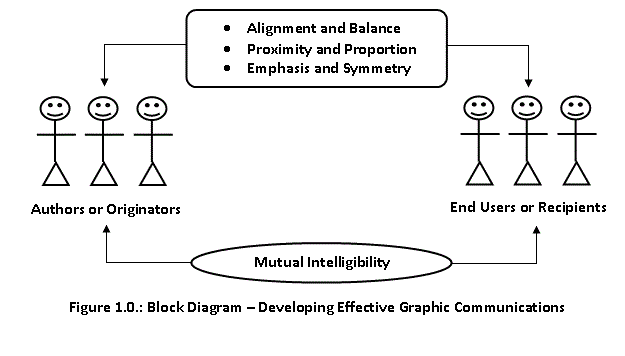Developing Effective Graphic Communications
Graphic communications fall into the broad class of non-verbal communications. The processes associated with the development of graphic communications involve the interpretation of data and exchange of information through the use of well arranged and structured elements, symbols, depictions and illustrations (Oladumiyte, 2014). To develop effective graphic communications, a high level of clarity, coherence, consistency and mutual intelligibility must be ensured in all the associated processes. In other words, end users of developed graphic communications must be able to decipher, interpret and act on the message conveyed by the authors clearly, coherently and consistently. (State University of New York, 2008)
The primary essence of graphic communications is to capture ideas and concepts that may be too complex and or cumbersome to express verbally or in full text formats in visually appealing frames or designs (Pennisi and Winder, 2011). Developing an effective graphic communications places a demand on authors or originators to focus strongly on concepts and designs that are firmly rooted in the end-users’ or recipients’ framework of understanding (Moore, 1997). As a vital routine in professional communications, the scope of graphic communications is multidimensional. However, the perspectives for the evaluation of the effectiveness of graphic communications are unambiguous. As inferred by (Carr and Harrington, 2011), these perspectives can be identified through an understanding of the strengths and weaknesses of visual perception.

As depicted in figure 1.0, some of the perspectives to take cognisance of in developing an effective graphic communications include alignment and balance, proximity and proportion, emphasis and at the risk of repetition, mutual intelligibility. Though these perspectives bear a similitude in their roles, they offer marked distinctions which can be clearly understood. (Pennisi and Winder, 2011)
REFERENCES
Carr, R. and Harrington, M. (2011) Effective Communication through Visual Design: Tables and Charts
Retrieved from: http://aaude.org/system/files/documents/public/strategy-institute-handout-final.pdf
Moore, H. A. (1997, January). Developing Effective Graphic Trial Communications Modification of a paper presented at the Defense Research Institute Seminar on Products Liability, San Diego, California. Retrieved from: http://trialpractices.com/PDFs/Graphictrial.pdf
Pennisi, L. A. And Winder, Alexis A. (2011, January) Effective Graphic Design (University of Nebraska – Lincoln Extension, Institute of Agricultural and Natural Resources) Retrieved from: http://ianrpubs.unl.edu/live/g2031/build/g2031.pdf
Oladumiyte, E. B. (2014, July). Graphics Communication an Appraisal of an Art of Learning in Contemporary Nigerian Education, Art and Design Review, 2, 29 – 39. http://dx.doi.org/10.4236/adr.2014.23005
State University of New York (2008) Handbook for Effective Professional Communication (Faculty of Forest and Natural Resources Management Undergraduate Education Committee) Retrieved from: http://hplengr.engr.wisc.edu/Prof_Comm.pdf